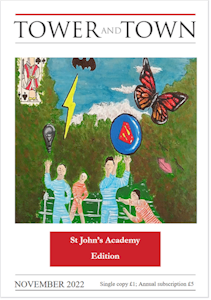

Tower and Town, November 2022 (view the full edition) (view the full edition)Nature Notes: Raptor WatchA large, bare field at the foot of the Downs seems bereft of life, but as a Buzzard lazily cruises overhead a mixed flock of birds gets up - a dozen Lapwings with their distinctive floppy flight and a larger group of slightly smaller birds with sickle-shaped wings flying in formation and calling with soft whistles, Golden Plover, winter visitors from Northern Europe and Britain. It’s mid-afternoon on a cold November day with light beginning to fade after three o’clock. It is then on a favoured spot in the Salisbury Plain Training area that dedicated birders and photographers gather, waiting for the arrival of special birds of prey in an area of unimproved grassland dotted with small bushes, and I’ve joined them.  First to appear is a Short-Eared Owl, cruising back and forth low over the ground in search of field voles, and then another, emerging from a fold in the downs. When there is a “plague of voles” the Owls, which are scarce but regular winter visitors to Wiltshire, will suddenly appear in numbers, and then just as suddenly disperse. It’s a glamorous bird, the short ears just about visible when it perches on a bush, the plumage a subtle mix of browns, oranges and pale ochres. The photographers are clicking away…………… A Kestrel hovers and a Red Kite sails past, but the birders are looking for something much more exciting: as the light begins to go there it is, a beautiful male Hen Harrier, gliding past slowly, close to the ground on long, grey V-shaped wings. Some of our wintering individuals may originate from Fenno-Scandinavia and the Netherlands, but a number of ringed birds have come from Wales and Scotland. The term "harrier" refers to its former habit of preying on free-ranging fowl, it’s winter diet mainly consisting of short-tailed voles, meadow pipits and skylarks. A small falcon is perched upright on a post, before taking off and zig-zagging in the air pursuing a lone skylark. It’s a female Merlin hoping its prey will tire and give up the ghost, but it doesn’t, and the Merlin goes hungry. Some will have got that special shot of the Owl as it turned in the air, and it is good that the shooting is with a camera, not with a gun. I make my way home in the dark, happy to have experienced a raptor watch, but there is another surprise awaiting me. Along the West Kennet Avenue a bird rises up from a fence-post: a beautiful Barn Owl, caught in the car lights, vanishing on silent wings to hunt for mice. Robin Nelson |